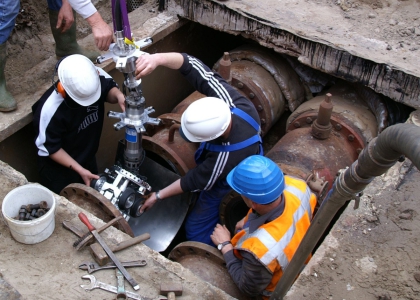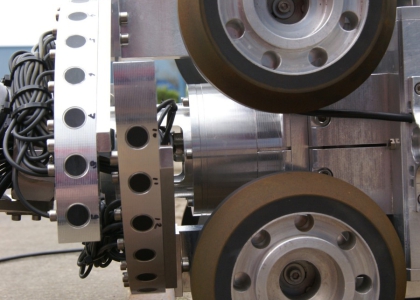District heating pipelines function hidden away and are an important part of urban infrastructure. Private homes and buildings such as schools and hospitals are supplied with heat that is mainly used for heating purposes. The individual pipelines are laid underground and form an extensive network in entire city centre area.
Complete inspection and renovation of the network from outside is not possible in practice as district heating pipelines are laid under busy streets, tunnels, local and underground railways.
Considerable cost savings
In the Rotterdam metropolitan area several sections of the district heating network were inspected with a special ultrasonic inspection robot and chekked for external corrosion in the summer of 2006 and 2007. Detected areas could then be specifically renovated and large-scale replacement of the pipelines avoided. This has contributed to not inconsiderable cost savings.
The inspection robot used in Rotterdam was developed in conjunction with ApplusRTD b.v. It can travel through pipelines with a diameter range of approx. 300 to 600 m over a total length of up to 250 meters and carry out a detailed internal inspection. With the aid of the most modern ultrasonic examination technology it can also determine the wall thickness of the pipeline to degree of 100% and detect any external or internal damage.
The flexible structure of the ultrasonic inspection robot again proved to be a great advantage, It can be used in very constricted conditions in the pipeline and pass through narrow bends. In order to introduce it an opening of approx. 400 mm in the axial direction only has to be created. This can be achieved, for example, by removing compensator elements. Further measures are not necessary.
The Dutch energy provider ENECO b.v. has utilized these advantages and with its involvement the ultrasonic inspection robot has been adapted for special use.
Data available in real time
The inspection robot comprises two drive elements, the wheels of which are pneumatically pressed against the inside wall of the pipe. They thus develop the high traction force required for longer pipeline sections with bends. At its end is an electronic module for ultrasonic inspection equipment. A special cable connects the inspector robot to the control and evaluation unit for the inspection equipment. Just in time: all ultrasonic data are immediately available in real time and can be evaluated even during the inspection.
The installation of an inspection camera guarantees an overview in the pipeline. Arranged on the rear drive element is the inspection head with a total of 32 ultrasonic inspection heads. Consisting of two semicircular partial elements it can be pneumatically moved on the internal wall of the pipeline. The carrier is adjustable and allows precise adaptation to the pipeline size.
If the pipeline was not to be completely filled with water a second ultrasonic inspection element with 32 sensors was deployed. This could be filled with water via a type of chamber with two sealing disks.



